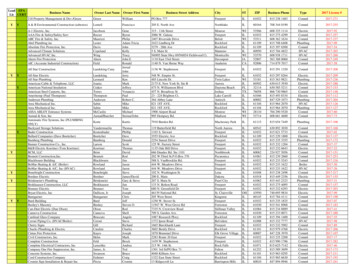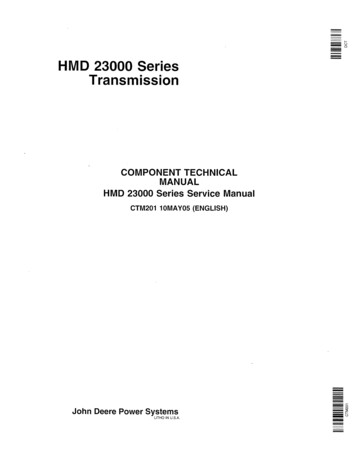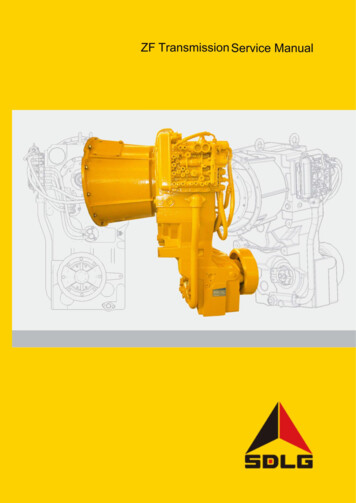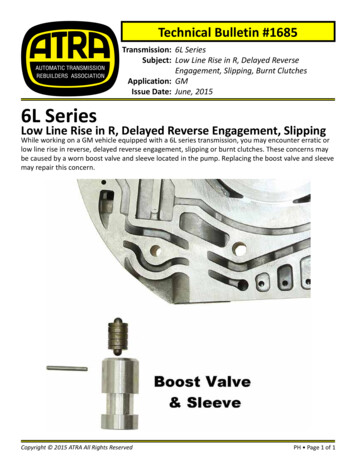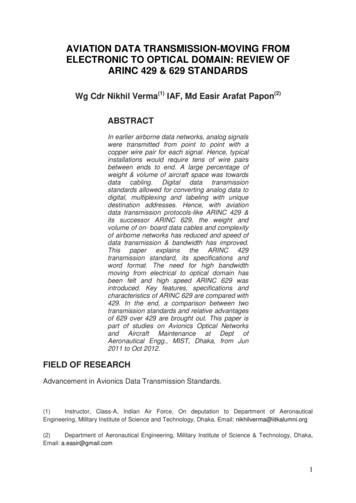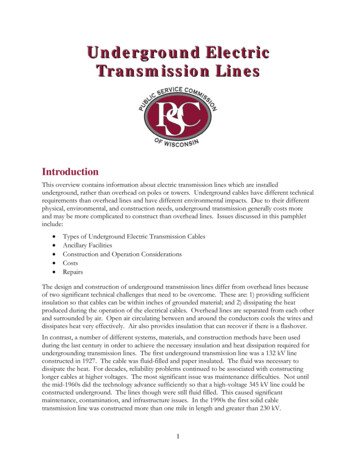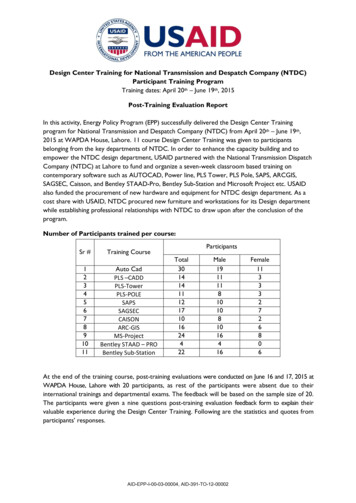
Transcription
Considerations for Transmission Owner(TO) Control Centers (TOCC) with Capabilityto Perform Transmission Operator (TOP)ObligationsProject 2016-02 Modifications to CIP StandardsMarch 14, 2017IntroductionThe “TOCC White Paper” provides background and technical considerations for potential approaches tomodifying the applicability of North American Electric Reliability Corporation (NERC) Critical InfrastructureProtection (CIP) Reliability Standards as they relate to the protection of BES Cyber System(s) atTransmission Owner Control Centers performing the functional obligations of a Transmission Operator.The TOCC White Paper was drafted by the standard drafting team (“SDT”) for NERC Project 2016-02Modifications to CIP Standards (Project 2016-02) for stakeholder consideration and comment. The TOCCWhite Paper has not been approved or endorsed by NERC. The SDT is using the TOCC White Paper as astandard development tool to collect feedback on the basis for revisions to the CIP standards on thisissue, if any.As outlined in the applicable Standards Authorization Request (SAR), NERC Project 2016-02, addresses theFederal Energy Regulatory Commission (FERC or Commission) Order No. 822 directives and the issuescaptured in the Version 5 Transition Advisory Group’s (V5TAG) CIP V5 Issues for Standard Drafting TeamConsideration (V5TAG Transfer Document). The V5TAG, comprised of representatives from NERC,Regional Entities, and industry stakeholders, was formed to issue guidance regarding possible methods toachieve compliance with the CIP V5 standards and to support industry’s implementation activities. In theTransfer Document, the V5TAG outlined the issues which it believed required further modification orclarification within the CIP Reliability Standards. The necessary modifications were believed to supporteffective implementation; critical infrastructure security improvements; and/or consistency in ComplianceMonitoring and Enforcement outcomes.Among other things, the V5TAG Transfer Document proposes that the CIP SDT address the applicability ofthe CIP Reliability Standards to BES Cyber System(s) for a TO Control Center performing the functionalobligations of a TOP. As such, the SAR for Project 2016-02 lists the following issues for the Project 2016-02SDT to address:1. The applicability of requirements on a TO’s Control Center that performs the functional obligationsof a TOP, particularly if the TO has the ability to operate switches, breakers and relays in the BulkElectric System (BES);2. The definition of Control Center; and
3. The language scope of “perform the functional obligations of” throughout the Attachment 1criteria.To address the issues listed, the SDT identified the following five areas for examination and discussion: (1)the TOCC responsibilities as they relate to TOP functions or tasks within the NERC registration processes;(2) the roles that entity impact analyses and risk assessments play, including the NERC proposed betacriteria; (3) understanding of the phrase "performing functional obligations;" (4) a technical discussion onthe capability vs. authority and span of control of BES Cyber System(s) associated with TOCCs; and (5)consideration of potential solutions. Each of these areas is discussed in this TOCC White Paper.The SDT is seeking stakeholder feedback on its assessment of the TOCC issue area through the associatedinformal comment form. In particular, the SDT seeks feedback on the potential solutions proposed in thisTOCC White Paper as well as any suggestions for alternative solutions.V5TAG BackgroundAs described in the NERC Project 2016-02 Standards Drafting Team SAR encompassing the V5TAG transferdocument issues, there were multiple readings of the language “used to perform the functional obligationof” in CIP-002-5.1a, Attachment 1, criterion 2.12 and recommendations for clarification of: The applicability of requirements on a TOCC that performs the functional obligations of a TOP,particularly if the TO has the ability to operate switches, breakers and relays in the BES. The definition of Control Center. The language scope of “perform the functional obligations of” throughout the Attachment 1criteria.The V5TAG suggested that the Project 2016-02 SDT consider the following potential options orrecommendations for resolution: Provide additional clarity or revisions to CIP-002-5.1a, Attachment 1. Specifically aroundTransmission Owner Control Centers performing the functional obligations of a TransmissionOperator, in particular for entities with small or lower-risk Cyber Asset risks. Clarify applicability of requirements on a TOCC that perform the functional obligations of a TOP,particularly if the TO has the ability to operate switches, breakers and relays in the BES. Currently,CIP-002-5.1a indicates that any Control Center performing the actions noted above is to beconsidered as having BES Cyber Systems categorized as medium impact, if not already identified ashigh impact. There is no allowance for a low-risk entity performing TOP functions to identify theirassets as containing only low impact BES Cyber Systems. Revise the definition of Control Center if additional clarity will improve consistency inimplementation, compliance and enforcement, and determination of applicability.The TOCC whitepaper is an effort to fully inform industry about this issue and the SDT needs feedbackfrom all industry participants on the topics in the associated comment form.TOCC White PaperProject 2016-02 Modifications to CIP Standards March 20172
Related Issues Not in Scope of SARAs described in the Standards Processes Manual, a SAR is the form used to document the scope andreliability benefit of a proposed project for one or more new or modified Reliability Standards ordefinitions or the benefit of retiring one or more approved Reliability Standards.Early in the SDT research effort, discussions with stakeholders revealed a potentially significantconnection between the TOCC issue and the ERO Registration processes. The SDT explored this path andcaptured the following information.In 2014, NERC completed development of a Risk-Based Registration process, which FERC approved in2015. During the development effort, NERC considered the concept of a registration lite for those entitiesthat may perform functional obligations but have less reliability impacts to the BES. These concerns werenot specific to a registered function but were entity-dependent having a relationship with the TOCC. TheRisk-Based Registration process concluded and determined there was not a defensible position for aregistration lite concept, but given the remaining concerns, the ERO established NERC-led review panelsdeveloped from the Risk-Based Registration process to assess and confirm an impact rating for TOCCs,should the question arise in the future.The review panel can be utilized for concerns with registration as a TO or TOP if the entity believes thedesignation it carries to be inappropriate. Entities that may be impacted by a change in a neighboring orfellow registered entity have a chance to participate in the panel process. To be more direct in linkage, ifan entity has concerns about applicability of functional performance or tasks – this would not beaddressed in a family of standards – but in the tools and programs as defined in the NERC Rules ofProcedure (ROP). These are the ordered processes for any type of exception, if you will, from adherenceto the standards and requirements.In discussions with impacted stakeholders, the SDT learned that some TOPs believe they areinappropriately registered as TOPs and, as a result, are disproportionately impacted by the CIP standards.This registration issue is outside the scope of Project 2016-02. The SDT notes, however, that entities mayuse existing mechanisms to potentially resolve these concerns.NERC Project 2016-02 BackgroundOn January 21, 2016, the Commission issued Order No. 822, Revised Critical Infrastructure ProtectionReliability Standards, approving seven CIP Reliability Standards and new or modified definitions. OnMarch 9, 2016, the NERC Standards Committee (SC) authorized the SAR to be posted for a 30-day informalcomment period from March 23 – April 21, 2016. Based on the comments received, the SDT made minorrevisions to the SAR which was posted for an additional 30-day informal comment period June 1-30, 2016.The SC accepted the SAR revisions on July 20, 2016.The purpose of NERC Project 2016-02 is to increase reliability and security to the Bulk-Power System (BPS)by enhancing cyber protection of BPS facilities. To help accomplish this, the SDT will: (1) address theCommission directives contained in Order No. 822, and (2) consider the V5TAG issues identified in theV5TAG Transfer Document.TOCC White PaperProject 2016-02 Modifications to CIP Standards March 20173
It is important to note that the V5TAG issues relate to the language developed by the Project 2008-06Cyber Security Order 706 Standards Drafting Team (706 SDT) as directed in FERC Order No. 706. The NERCBoard of Trustees adopted the stakeholder-approved CIP Version 5 standards and FERC approved thestandards on January 18, 2006. The Project 2016-02 SDT must consider the V5TAG issues based on thelanguage of FERC Order No. 706 and the intent of the 706 SDT with a subset of the language capturedbelow.280. The Commission has two concerns regarding the misuse of facilities, and clarifies thoseconcerns here. First, Requirement R1.2.1 requires responsible entities to consider control centersand backup control centers as potential critical assets. In determining whether those controlcenters should be critical assets, we believe that responsible entities should examine the impacton reliability if the control centers are unavailable, due for example to power or communicationsfailures, or denial of service attacks. Responsible entities should also examine the impact thatmisuse of those control centers could have on the electric facilities they control and what thecombined impact of those electric facilities could be on the reliability of the Bulk-Power System.The Commission recognizes that, when these matters are taken into account, it is difficult toenvision a scenario in which a reliability coordinator, transmission operator or transmission ownercontrol center or backup control center would not properly be identified as a critical asset.FERC reiterated its position on April 19, 2012 in FERC Order No. 761 (the order approving “Version 4Critical Infrastructure Protection Reliability Standards”):57. The Commission recognizes the diverging views among commenters regarding the protectionof control centers and control systems afforded under the Version 4 CIP Reliability Standards. InOrder No. 706, we stated that “it is difficult to envision a scenario in which a reliabilitycoordinator, transmission operator or transmission owner control center or backup control centerwould not properly be identified as a critical asset.” The Commission maintains this view.However, as we observed in the NOPR, the percentage of control centers to be identified asCritical Assets under Version 4 is 74 percent, which is an improvement over the number currentlyidentified under Version 3. Therefore, it is reasonable to approve Version 4 because it will ensurethat more control centers are identified as Critical Assets than are identified under Version 3.However, we continue to expect comprehensive protection of all control centers and controlsystems as NERC works to comply with the requirements of Order No. 706.NERC Proposed Beta CriteriaPrior to the SAR, NERC compliance staff participating in the V5TAG recognized that Control Centerscovered by the referenced criterion may not all pose the same level of risk to the BES, which is afundamental aspect of CIP-002-5.1a impact-based categories. To evaluate each Control Center’s risk tothe BES, NERC compliance staff developed beta criteria to identify Control Centers that contain mediumimpact BES Cyber Systems and evaluate the entity risk impact with consideration of a low impactcategory. The beta criteria are more fully described below.TOCC White PaperProject 2016-02 Modifications to CIP Standards March 20174
The first beta criterion of the evaluation posed the following question: “Does the Transmission Owner’sfacility operate at least two geographically separate transmission facilities?” If the answer to this betacriterion was no, the TO’s facility would be identified as an asset that contains low impact BES CyberSystems. If the answer was yes, then the evaluation moved on to the next criterion.The second beta criterion consisted of the following question: “Do any of the Transmission Facilitiesoperated by the Transmission Owner’s Control Centers operate at or greater than 200 kV?” If the answerto this question was yes, then the evaluation resulted in the Control Center being identified as an assetthat contained medium impact BES Cyber System(s). If the answer to this question was no then theevaluation proceeded to the next criterion.The third beta criterion was labeled as the Group 1 criteria and consisted of three distinct questions:1. “Does the Transmission Owner control 1500 MVA or more of Transmission capacity at BESTransmission Facilities controlled by the Transmission Owner’s Control Centers?” It should benoted that this is not Transfer Capability through a Transmission Operator Area. Transmissioncapacity in this criterion was calculated by adding up the Facility ratings of all the TransmissionOwner’s BES Transmission Lines and capacitor banks. If the aggregated MVA value was greaterthan or equal to 1500 MVA, then the Control Center was identified as an asset that containsmedium impact BES Cyber System(s). If the answer to this question was no, then the evaluationmoved on to the next question.2. “Does the Transmission Owner control more than 200 miles of Transmission?” This calculation wasperformed by adding up all of the circuit miles of the Transmission Owner’s BES TransmissionFacilities. If the answer to this question was yes, then the Control Center was identified as an assetthat contained medium impact BES Cyber System(s). If the answer was no then the evaluationmoved on to the final question.3. “Has the Transmission Owner been notified by its Reliability Coordinator, Planning Coordinator, orTransmission Planner as having a Facility, controlled by the Transmission Owner’s Control Centersthat is critical to the derivation of Interconnection Reliability Operating Limits (IROLs) and theirassociated contingencies?” If the answer to this question was yes, then the Control Center wasidentified as an asset that contained medium impact BES Cyber System(s), if not it was treated asan asset that contains low impact BES Cyber System(s).The SDT continues to evaluate the beta criteria as an option to pursue. In an effort to clarify the approachas captured, the following flowchart represents the consideration path for execution of the riskassessment.TOCC White PaperProject 2016-02 Modifications to CIP Standards March 20175
NERC Criteria and Decision Tree:Evaluation of Control CenterImpacts on the BESTO Operates TwoGeographically SeparateFacilitesNOYesTO Control CenterOperates Facilities Rated 200kVNoYesLow Impact BESCyber SystemMedium Impact BESCyber SystemTO Control CenterControls 1500MVA BESTransmission FacilitiesYesYesNoTO Control 200 CircuitMiles of BESTransmission FacilitiesYesNoTO Notified: Critical to theDerivation of IROLs &Associated ContingenciesTOCC White PaperProject 2016-02 Modifications to CIP Standards March 2017No6
Performing Functional ObligationsThe SDT delved further into the intent behind the language: “performing the functional obligations of”and identified the following information associated with the creation of this language. The “performingfunctional obligation of” language was added in CIP-002-4 by the “Project 2008-6 Cyber Security OrderPhase II” Standard Drafting Team. The CIP-002-4 Identifying Critical Cyber Assets guideline documentreferences the “functional obligation” language in terms of a “formal delegation” from the 024RD/Project 2008-06 CIP-002-4 Guidance clean 20101220.pdfThe “functional obligations” language first appears in a draft of CIP-002-4. The draft guidance associatedwith this first introduction of the language offered the following:Part 1.14 designates all control centers and control systems used to perform the functional obligations of theReliability Coordinator (RC), Balancing Authority (BA) or Transmission Operator (TOP). EOP-008 requires that RCs, BAsand TOPs “ensure continued reliable operations of the Bulk Electric System (BES) in the event that a control centerbecomes inoperable.” While it is clear that the primary and all backup control centers operated by RCs, BAs, and TOPsmust be designated as Critical Assets, control systems at other applicable Responsible Entities that are used toperform the functional obligations of the RCs, BAs, or TOPs must also be designated as Critical Assets. These includecontrol systems at Transmission Owners’ control centers and backup control centers, for example, which have beenformally delegated to perform some of these functions. Control systems were specifically called out separately fromcontrol centers to ensure that Entities fully evaluate those systems used to perform the functional obligations of theReliability Coordinator, Balancing Authority, or Transmission Operator. These control systems may be located at a datacenter that is not co-located with the control center itself.As discussed in summary meeting notes from the aforementioned SDT, the SDT commented on thedesignation of TOCC’s as Critical Assets as follows:“As discussed in the Reference Document, this requirement is sourced from EOP-008. Control centers performingthese functional obligations are considered important enough to require mandatory backup requirements andwarrant designation as Critical Assets.”Given the information discussed above, the relationship to the operations and planning standards varywith different levels of potential impact. To perform functional tasks or obligations, a System Operatormust either be certified as a Transmission Operator or Reliability Coordinator (RC) or take direction from aNERC-certified System Operator (Transmission Operator or RC). Maintaining a NERC certification can takesignificant investment of time and resources, so some System Operators that control BES TransmissionSystems do not maintain certification and instead rely on only operating the System when directed by aNERC Certified System Operator. To address the scenario where an individual or entity is 1) performingBES Transmission operations, 2) is not a registered TOP and 3) equipment may have an impact on BESoperations, the 706 SDT incorporated the language “used to perform the functional obligations of” toclarify that the equipment used by both NERC-certified System Operators and System Operators operatedunder the direction of a NERC-certified System Operator had to be protected and fully implement thesecurity objective for protecting equipment used to perform TOP functions. The functional obligations ofa TOP are identified in the NERC Rules of Procedure 1, with further examples included in the leOfProcedureDL/NERC ROP Effective 20161031.pdfTOCC White PaperProject 2016-02 Modifications to CIP Standards March 20177
Model and are also summarized in the BES Reliability Operating Services (BROS) in the Guidelines andTechnical Basis of CIP-002-5.1a.1) Capability versus AuthorityIn terms of CIP-002-5.1a and determination of risk level or impact classification, Attachment 1 criterion2.12 focuses specifically on those Responsible Entities taking part in or performing both the TransmissionOwner and/or the Transmission Operator reliability functions. As stated in
Board of Trustees adopted the stakeholder-approved CIP Version 5 standards and FERC approved the standards on January 18, 2006. The Project 2016-02 SDT must consider the V5TAG issues based on the language of
